Abstract
Coumarin and its derivatives have significantly attracted the attention of medicinal chemists and chemical biologists due to their huge range of biological, and in particular, pharmacological properties. Interesting families of coumarins have been found from marine sources, which has accelerated the drug discovery process by inspiring innovation or even by the identification of analogues with remarkable biological properties. The purpose of this review is to showcase the most interesting marine-derived coumarins from a medicinal chemistry point of view, as well as the novel and useful synthetic routes described to date to achieve these chemical structures. The references that compose this overview were collected from PubMed, Mendeley and SciFinder.
1. Introduction
The ocean can be considered the cradle of living organisms and the first and biggest ecosystem of our planet. The diversified environments found in different oceanic zones have been a matter of study since ancient times, as marine natural products have been used in functional foods, dietary supplements and medicine. The interest in marine pharmacology to discover organic molecules with active pharmaceutical properties clearly supposes a renaissance in drug development based on natural products due to the chances to increase the chemical space from this underexplored ecosystem. Compared with terrestrial substances, marine substances have different chemical features with sometimes better mechanisms of defense. It is very likely that, under the extreme conditions (e.g., low levels of oxygen, high pressures, absence of light) in which deep sea organisms live, they have adapted to this environment undergoing biochemical or physiological transformations to survive, providing sophisticated organic skeletons with interesting drug-like properties [1,2].
On the other hand, the design and synthesis of molecules in the drug discovery process is a real challenge for a medicinal chemist, as a vast number of new chemical entities have to be prepared from hit identification (Hit Id.) to a late lead optimization (LLO) process. It is estimated that approximately more than 12 years with a cost of more than one billion EUR are needed to bring a new drug to the market [3]. An alternative pathway in drug discovery programs has been the identification of “advanced chemical entities” which can provide valuable information against a molecular target. In this regard, the development of drugs based on natural product structures has been investigated for decades, providing a clear way to reduce both time and cost. Considering marine sources, around 3,000 entities with biological properties have been identified [4], which would clearly facilitate drug discovery programs in the search for new therapies [5,6,7].
Coumarin is considered a privileged scaffold that has extensively attracted the attention of the scientific community in a wide range of applications [8,9,10,11,12]. Chemically, coumarins belong to the family of lactones (2H-1-benzopyran-2-one, 1,2-benzopyrone or benzo-α-pyrone) and consist of fused benzene and α-pyrone rings. A general classification considering its structure would be simple coumarins, furanocoumarins, pyranocoumarins, dihydrofurano coumarins, phenylcoumarins and bicoumarins.
They have been used in many research areas, such as cosmetics, food additives, fluorescent probes and laser dyes, among others [13]. However, coumarin derivatives have created a major impact in medicinal chemistry, where most of these derivatives have shown interesting pharmacological properties including anticoagulant, anti-inflammatory, antiviral, antioxidant, anticancer and inhibitory of enzymes [14,15,16,17,18,19]. Thus, they have been used in a variety of biological targets. For instance, acenocoumarol (1) and warfarin (3) are representative approved drugs with anticoagulatory activity, whose clinical results were studied on 2111 MPHV patients [20]. Hydroxycoumarins show promising results in the treatment of inflammation [21,22], and coumarin–chalcone and coumarin–resveratrol hybrids were studied in the treatment of neurodegenerative diseases [9,23,24]. In addition, some anticancer activities against HepG2 and HeLa cancer cell lines have been reported for the combination of simple coumarins with sorafenib (Figure 1) [25,26].
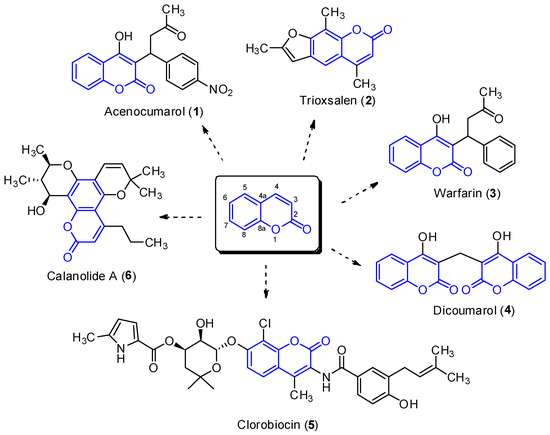
Figure 1.
Representative examples of active coumarin derivatives.
The distribution of coumarins in nature is ubiquitous. Coumarins may be found in plant roots, seeds, leaves, flowers, peels and fruits, as secondary metabolites. Their extraction and isolation from various plant species has been extensively studied due to their relevant biological activity in many therapeutic areas [27]. Some coumarin structures have also been identified in marine sources, especially in algae, marine fungi and ascidians. As shown before, new bioactive molecules from oceans could facilitate the discovery of chemical analogues with potential applications in drug discovery. For this reason, the purpose of this review is to exclusively cover coumarin derivatives from marine sources with a pharmacological interest, as well as the novel or fruitful synthetic routes described to obtain these privileged scaffolds.
2. Coumarin Derivatives from Marine World: Synthesis and Activities
The biological properties of coumarin derivatives have been studied in a variety of fields. The great interest that this family of compounds has attracted along the years is reflected in the number of research and review papers dedicated to this topic on PubMed (more than 2000 in just 2022). For marine-derived coumarins, their cytotoxic properties are by far the most studied.
Coumarins from oceans have been mostly found in coastal plants, bacteria, mollusks, invertebrates and sponges [10]. However, extraction from natural sources is time-consuming and the amount of isolated compound is usually scarce. In this sense, many efforts have been made to afford fruitful synthetic routes in various operational steps to achieve the desired derivatives.
In this review, we will simulate showcasing the pharmacological activities and relevant synthetic routes for specific families of derivatives and their analogues. Novel methodologies developed during the last years will also be covered to illustrate new synthetic opportunities.
Although a general classification of coumarin derivatives has been presented in the Section 1, a suitable classification of coumarins from the marine world into different categories would be more appropriate. For simplicity, we will distinguish between simple, 3-substituted (amino- and imino-), tricyclic (benzo- and furo-), pentacyclic and other coumarin analogues.
2.1. Simple Coumarins
Simple substituted coumarins are the structurally less complex class of coumarins. The scaffold is constituted by a bicyclic system and different substitution patterns at the C-3, C-4, C-5, C-6, C-7 and C-8 positions. Due to the already defined biological activity [28,29], two compounds—umbelliferone (7, R7 = OH) and scopoletin (8, R6 = OCH3 and R7 = OH) —are highlighted here (Figure 2). These molecules were isolated in 2012 from the leaves of the mangrove endophytic fungus Penicillium sp. ZH16 from the South China sea [30].
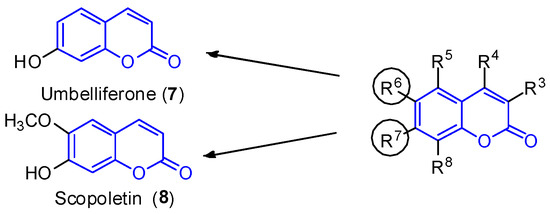
Figure 2.
Simple coumarin derivatives: umbelliferone (7) and scopoletin (8).
Umbelliferone (7) shows anti-inflammatory [31] and antitumoral activities [32]. In 2015, Yu et al. reported the anticancer activity of umbelliferone (7) against HepG2 cancer cells, inducing apoptosis in cells [33], whereas scopoletin (8) inhibits PC3 proliferation, a human prostate cancer cell line [34]. Additionally, both compounds exhibit anti-acetylcholinesterase (AChE) [35,36] and antioxidant activities [37].
As a result of the importance of these scaffolds in organic and medical chemistry, many synthetic routes to obtain simple substituted coumarins have been explored over the years [38,39]. The most classical strategies involve Knoevenagel [40], Pechmann [41] and Perkin [42] condensations, intramolecular [43,44] and intermolecular Wittig reactions [45], ring-closing metathesis [46], as well as different reactions between the corresponding salicylaldehydes with ketene [47] or arylacetonitriles (18) [48] (Scheme 1).
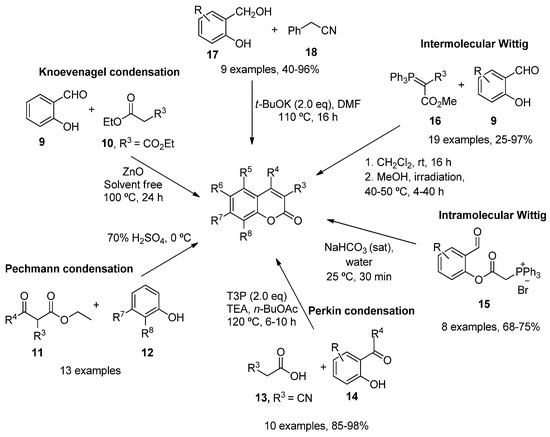
Scheme 1.
Synthetic approaches in the preparation of functionalized coumarins.
Over the last few years, transition metal catalysis, involving palladium [49,50], rhodium [51], iron [52] or cobalt [53], has also been used to synthesize different coumarin derivatives. In addition, modern methodologies such as microwave irradiation [54,55], flow chemistry [56], photochemistry [57], ionic liquids [58,59] and organocatalytic reactions [60], proved to be very effective.
For instance, Y. Li et al. employed the photocatalytic isomerization of ortho-E-hydroxycinnamates (19) to generate Z isomers, which underwent lactonization to provide coumarin compounds in high yields (Scheme 2) [61]. A similar strategy was developed by Shu et al. but using Ir2(ppy)4Cl2 as the catalyst (Scheme 2) [62].

Scheme 2.
Photocatalytic reactions in the synthesis of coumarins.
Au(I)-catalysts have also been screened to synthesize coumarins by the intramolecular arylation (IMHA) of phenol-derived propiolates (20) [63]. IMHA reactions were carried out using Echavarren’s catalyst (21), (acetonitrile)[(2-biphenyl)di-tert-butylphosphine]gold(I) hexafluoroantimonate, to give numerous derivatized compounds in high yields (Scheme 3).

Scheme 3.
Gold(I)-catalyzed reaction in the preparation of coumarin derivatives.
Furthermore, other metal-free methodologies have been reported. In 2016, Lee et al. reported a TfOH-mediated condensation of phenols (22) with propiolic acids (23), followed by intramolecular arylation [64], which was applied to obtain natural umbelliferone (7) in an 81% yield (Scheme 4).

Scheme 4.
Metal-free methodology for the preparation of umbelliferone (7).
2.2. 3-Substituted (Imino- and Amido-) Coumarins
2.2.1. 3-Iminocoumarins
All 3-iminocoumarins (24–39) reported in the literature have been isolated from mangrove fungi present in the South China sea, along with tens of other metabolites [65]. To the best of our knowledge, these compounds do not show relevant biological activity, and no synthetic approaches have been published to date (Figure 3).
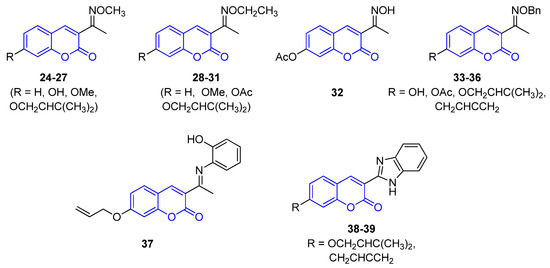
Figure 3.
Representative examples of iminocoumarins from marine sources.
2.2.2. 3-Amidocoumarins
Trichodermamide A (40), B (41) and aspergillazine A (42) were the first 3-amidocoumarins isolated at the beginning of the 21st century from different marine-derived fungi, Trichoderma virens and Spicaria elegans [66,67,68]. Spectroscopic analysis and chemical methods (a modified Mosher’s method) allowed for the determination of the structure and stereochemistry of 40 [66] and 42 [69], while the structure of 41 was established by X-ray diffraction analysis (Figure 4) [66].
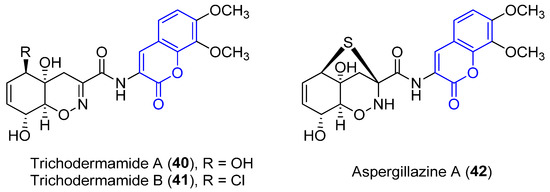
Figure 4.
Representative examples of amidocoumarins from marine sources.
Compounds 40 and 42 proved to display a weak cytotoxic activity against an HL-60 cell line (IC50 = 89 and 84 Μm, respectively) [67]. By contrast, as a result of the presence of the chlorohydrin group in 41, it displays in vitro cytotoxicity against HCT-116 colorectal cancer cells (IC50 = 0.32 μg/mL) [66] and HeLa cells (IC50 = 3.1 μM), by breaking double-stranded DNA [70]. Moreover, weak antimicrobial activities have been reported [68].
Recently, four new 3-amido compounds have been isolated (Figure 5). On the one hand, long-term static fermentation of the strain of Trichoderma sp. TPU199 (cf. Trichoderma brevicompactum) induced the production of dithioaspergillazine A (43), which possesses a disulphide bridge by comparison with spectroscopic data. In contrast to aspergillazine A (42), the compound inhibits the proliferation of the colon cancer HCT-15 cell line (IC50 = 13 μM) and Jurkat leukemia cells (IC50 = 1.3 μM) [71]. On the other hand, trichodermamide C (44) and hatsumamide A (45) and B (46) were isolated from the deep sea-derived fungus Penicillium steckii FKJ-0213 by physicochemical (PC) screening [72]. The structure of 44, which also contains a 1,2-oxazine system, was previously established by NMR, UV, IR, MS and X-ray diffraction data. It shows moderate cytotoxic effects towards human colorectal carcinoma HCT116 (IC50 = 0.68 μg/mL) and human lung carcinoma A549 (IC50 = 4.28 μg/mL) [73]. The structure and stereochemistry of 45 and 46 were elucidated by mass spectrometry, 1D and 2D NMR data (COSY, HMQC, HMBC and ROESY) and by comparing data with other already known compounds. No biological activity of 46 has been reported. However, 45 presents antimalarial activity against the K1 and FCR3 strains of Plasmodium falciparum, with IC50 values of 27.2 an 27.9 μM, respectively, and cytotoxicity against five human tumor cell lines, HeLa S3 (IC50 = 15.0 μM), HT29 (IC50 = 6.8 μM), A549 (IC50 = 13.7 μM), H1299 (IC50 = 18.7 μM) and Panc1 (IC50 = 12.9 μM) [72].
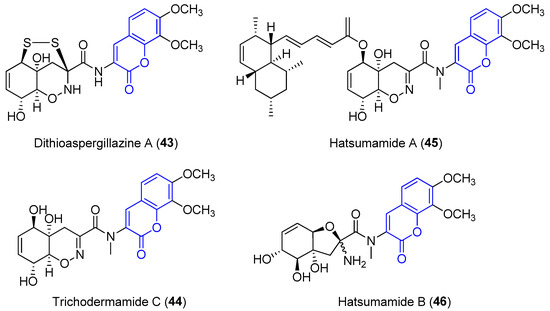
Figure 5.
Other examples of amidocoumarins from marine sources.
Trichodermamides 40, 41 and 44 could be disconnected into two fragments: an oxazine ring moiety 47 and an aminocoumarin 48 (Scheme 5). Different synthetic strategies have been developed in order to afford the 4H-5,6-dihydro-1,2-oxazine fragment 47.

Scheme 5.
Retrosynthetic analysis for the preparation of trichodermamides.
In 2008, Joullié and Wan described the total synthesis of 40 and 41 [74]. Thus, the advanced intermediate 52, obtained in 18 linear steps from (–)-quinic acid 49, was treated with hydroxylamine to obtain an oxime, which in situ underwent an intramolecular epoxide ring opening upon addition of NaOH. Oxazine 53, obtained as a single diastereomer, was then converted (over four reaction steps) into enone 54. A Luche reduction followed by selective primary alcohol oxidation provided acid 55 in a good yield (Scheme 6).
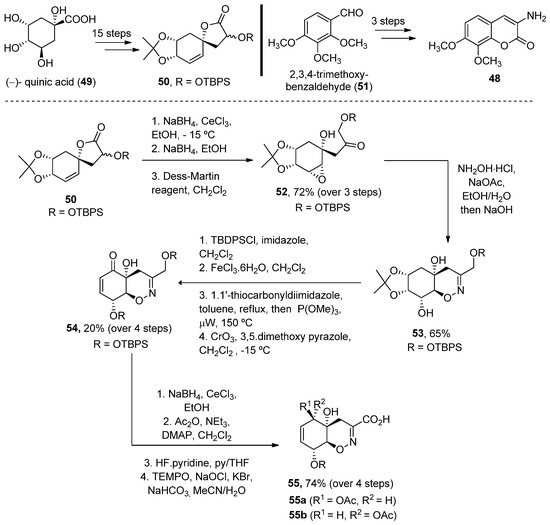
Scheme 6.
Methodology for the preparation of fragment G.
The coupling reaction between carboxylic acid 55 and aminocoumarin B (obtained in three steps from 3,4-trimethoxy-benzaldehyde) was performed using EDCI in 30% pyridine/dichloromethane. Compound 40 was obtained after coupling and two deprotection steps in a 53% yield, while 41 required an additional treatment with mesyl chloride in order to obtain the corresponding allylic chloride (32% over four reaction steps). The total enantioselective syntheses were achieved in 31/32 reaction steps, with an average of an 85% yield for each reaction step (Scheme 7) [74].
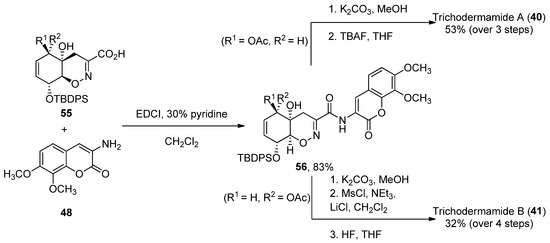
Scheme 7.
Final steps of the synthesis of trichodermamides A (40) and B (41).
More recently, a new concise total synthesis of trichodermamides A, B and C has been described [75]. A 1,2-addition of an αC-lithiated O-silyl ethyl pyruvate oxime 57 to benzoquine 58, followed by an oxa-Michael ring closure was applied to accomplish the formation of the cis-fused 1,2-oxazadecaline core 59 in a 92% yield. A modified Luche reduction and treatment with Pd(PPh3)4 in the presence of N,O-bis-(trimethylsilyl)acetamide (BTSA) was carried out to give dienol 60 in a high yield, a common intermediate in the synthesis of the three natural products (Scheme 8).

Scheme 8.
Methodology for the preparation of fragment 60.
Once the oxazadecaline 60 was obtained, similar chemical steps, but arranged in different order, provided the three natural compounds. In these syntheses, the two key steps are the amide coupling, mediated by HATU in the presence of sym-collidine, and a final selenoxide [2,3]-sigmatropic rearrangement with H2O2 in pyridine [76], which was previously used by Zakarian and Lu [77]. Trichodermamides 40, 41 and 44 have been obtained after 9, 12 or 13 steps, respectively, in moderate yields (Scheme 9).
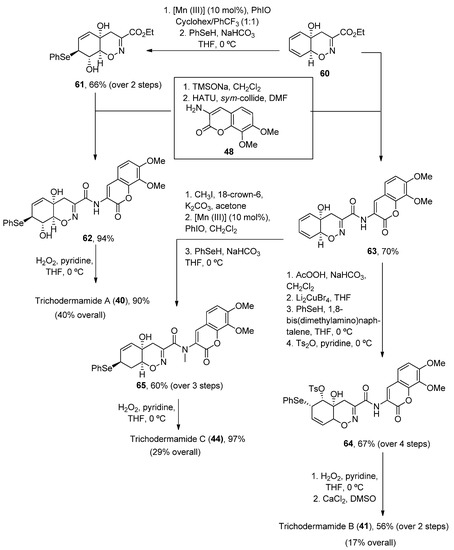
Scheme 9.
Synthetic methodology for the preparation of trichodermamides A (40), B (41) and C (44).
To the best of our knowledge, no synthetic approach for 42, 43, 45 and 46 has been reported yet.
2.3. Tricyclic Coumarins
2.3.1. Furocoumarins
First, furocoumarins (also called psoralenes) are described as coumarin derivatives with a fused furan ring with important biological activities, such as photoreactivity with DNA [78]. Four structures of furo[g]coumarins (66–69) were found in the endophytic fungus Penicillium sp. ZH16 from the South China sea (Figure 6) [30].

Figure 6.
Examples of furocoumarins from marine sources.
From this series, the derivative 68 was tested against KB and KBV200 cells demonstrating relevant cytotoxicity (IC50 of 5 and 10 μg/mL, respectively). In addition, 69 shows interesting photochemotherapeutic effects under near UV and blue light photosensitization (LD50 of 2 nM and 12 nM, respectively). These cytotoxic studies suggest the possibility of furocoumarins being involved in the high incidence of cancer in Nigeria [79].
The synthesis of furocoumarins has been known for a long time. However, novel methodologies have been developed during the last decades for the effective preparation of these compounds, many of which involve metal-catalyzed transformations that provide new structural diversity [80,81].
One such example has been the preparation of bergaptene (67). Although it was first isolated in 1834, it was not until 1936 when the first synthetic approach was described. Then, other methodologies were developed during the next decades [82]. Recently, Zhimin et al. reported a new synthesis of 67 in a higher isolated yield (55%) compared to the reported methodologies. Following known methodologies, phloroglucinol was used as the starting material to construct benzofuran-3-one 72 (by monomethylation and Pechmann reactions). Various conventional steps (acetylation, deacetylation) provided the intermediate 75 from which a fused lactone ring was constructed by acetylation and Pechmann condensation. A final dehydrogenation step with DDQ provided the final product 67 (Scheme 10).
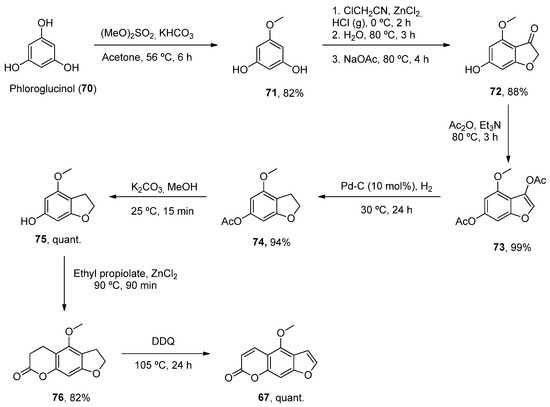
Scheme 10.
Synthetic methodology for the preparation of bergaptene (67).
2.3.2. Benzo[c]coumarins
Benzocoumarins are π-extended structures in which the coumarin core is fused with a benzene ring at different positions. Four benzo[c]coumarins (77–80, 3,4-benzocoumarins or alternariol derivatives) have been found from ocean sources, produced by the mangrove endophytic fungus No. 2240, from the South China sea coast (Figure 7) [83]. The structures were determined by spectroscopic analysis using NMR, IR and UV experiments and by comparison with the literature data.

Figure 7.
Examples of benzo[c]coumarins.
Alternariol (77, R1 = R2 = OH) and its derivatives (78–80) have demonstrated mutagenic properties against the human epidermoic carcinoma KB and KBv200 cell lines. In particular, 77 and 80 show stronger IC50 values (3.17, 3.12 and 4.82, 4.94 μg/mL, respectively) in both cell lines, in comparison with the weaker activities found for the other compounds (IC50 > 50 μg/mL).
The construction of benzocoumarins depends on the location of hydroxyl and formyl groups on the starting material, which is normally hydroxynaphthaldehyde. Many complementary strategies have been reported for the general synthesis of benzo[c]coumarin derivatives, which are based on carbon–carbon and carbon–oxygen bond formation strategies or cyclization reactions [84].
A total synthesis of 77 was described independently by the Podlech and Kim groups [85,86]. The key step in both protocols was a Suzuki–Miyaura cross-coupling of boronic acid 81 with a brominated aldehyde 82 to obtain an advanced precursor 83. A final cyclization step was needed to obtain the final product 77 (Scheme 11).

Scheme 11.
Critical key step in the total synthesis of alternariol (77).
More recently, the most common techniques in the synthesis of general benzo[c]coumarins have been the oxidative cyclization of biphenyl-2-carboxylic acid compounds [87] and Hurtley condensation [88]. However, other strategies that generate chemical diversity have been applied to obtain highly functionalized benzco[c]coumarins. For instance, Bodwell et al. prepared a set of benzo[c]coumarins by an inverse electron demand Diels–Alder reaction [89]. Later on, a multicomponent version (9, 84 and 85) comprising 6 reaction steps and increasing chemical diversity was disclosed by the same groups (Scheme 12) [90].
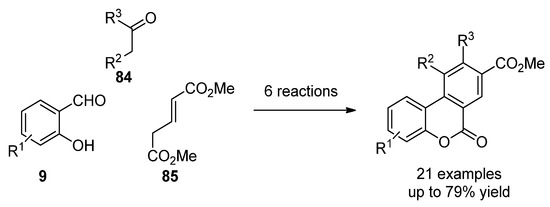
Scheme 12.
Multistep synthesis of benzo[c]coumarins.
Later, Lee’s group reported the reaction of hydroxychalcones (86) and β-ketoesters (87), in the presence of a base, in sequential Michael addition/intramolecular aldol condensation/oxidative aromatization/lactonization processes (Scheme 13) [91].

Scheme 13.
Domino reaction process for the synthesis of benzo[c]coumarins.
2.3.3. Other Tricyclic Coumarins
In addition to the previously mentioned groups, other tricyclic coumarins have been found in marine organisms. The limited number of their structural features does not allow for their classification in a particular group. Two pyrano[g]coumarins were isolated from Streptomyces violans bacteria and Ascomycete Leptosphaeria oraemaris fungi (compounds 87 and 88, respectively). In addition, iotrochotazine A (89) was found in the marine sponge Iotrochota sp. in Australia, and it is used as chemical probe to study Parkinson’s disease [92]. A series of dihydrocoumarins (90–95) was also found in Rhizophora stylosa mangrove trees in Okinawa, Japan. These compounds present DPPH free radical scavenging properties (EC50 4.6–10.3 μM) and serve as traditional medicine for the local people due to their antioxidant activities (Figure 8) [93,94].
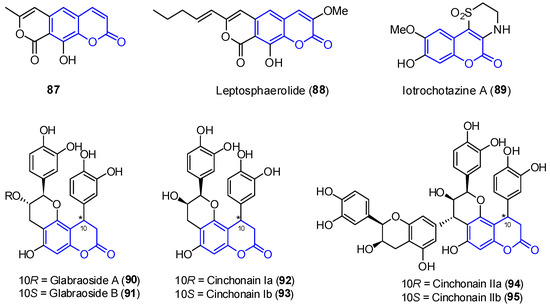
Figure 8.
Examples of tricyclic coumarins found from marine sources.
To the best of our knowledge, there are not many protocols reported for the preparation of each of these scaffolds. For instance, cinchonain derivatives 92 and 93 were successfully synthetized by the Kadota group, in a one-pot regioselective procedure involving a dienone–phenol rearrangement followed by a Michael-type reaction (Scheme 14) [95].

Scheme 14.
Synthesis of cinchonain.
Considering 89, a total synthesis was developed in 2014 through a one-pot enamine formation/intramolecular conjugate addition/oxidation sequence. The confirmation of the natural product allowed for subsequent biological investigations (Scheme 15) [92].
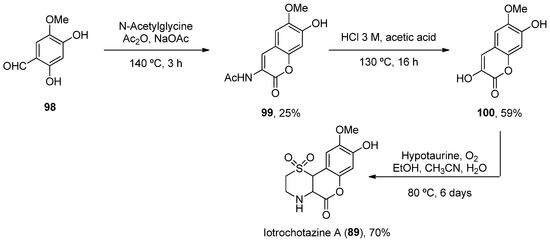
Scheme 15.
Synthesis of iotrochotazine A.
2.4. Pentacyclic Coumarins
2.4.1. Aflatoxins
These heterocyclic compounds are difurocoumarin derivatives consisting of a highly reactive bifuran ring and a five-membered lactone fused to the coumarin nucleus. Different aflatoxins (101–106) were found endogenously in Aspergillus flavus 092008 and in different algae in Putian Pinghai, China [96,97,98] (Figure 9).
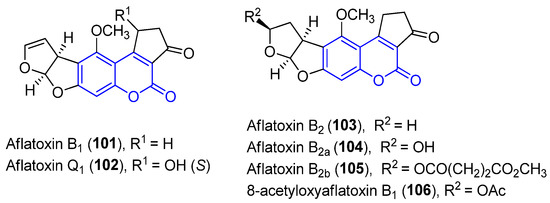
Figure 9.
Aflatoxin derivatives from marine sources.
Aflatoxins are toxic and described as among the most carcinogenic substances. They can be present as contaminants in food. Once in the body, they pass through the liver to generate a reactive epoxide intermediate, or they are hydroxylated to generate the less harmful aflatoxin M1. On the other hand, 101 has been analyzed against A549, K562 and L-02 cell lines, and a weak activity has been described (IC50 values 8.1, 2.0 and 4.2, respectively).
Due to the important implications of aflatoxins in human health and the problems associated with their extraction from natural sources, much progress has been made towards the total synthesis of both its racemic and asymmetric versions [99].
Outstanding contributions in the total synthesis were carried out by the Büchi group, such as the first total synthesis of 101 in a racemic version [100]. Considering this derivative as an example, an asymmetric total synthesis was developed for the first time by Trost et al. [101]. The synthesis of the key precursor 107 was carried out via a Pechmann reaction starting from 5-methoxy-m-catechol and β-keto ester. Then, the chiral center of the B ring was achieved in a high yield and ee through an allyl–palladium intermediate. Once synthetized, an intramolecular Heck reaction under standard conditions gave the new BC ring. A similar strategy allowed the construction of the final ring, which through acylation and pyrolysis generated the desired aflatoxin 101 (total yield in 9 steps of 1.6%) (Scheme 16).
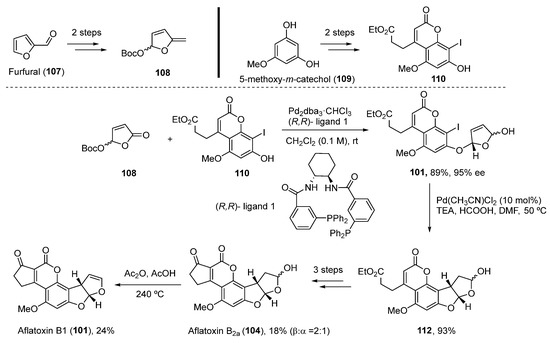
Scheme 16.
Synthesis of aflatoxin B2a (104) in 8 steps and aflotoxin B1 (101) in 9 steps.
2.4.2. Lamellarins
Most commonly, most of the coumarin derivatives extracted from marine sources correspond to lamellarins. This group of alkaloids, with an unprecedented chemical structure in the natural world, has been found in a plethora of marine invertebrates (sponges, tunicates and mollusks). Lamellarins A–D were first isolated in 1985 from the mollusk Lamellaria sp. in Palau, and over other 70 lamellarins have been isolated since then [102]. As shown in Figure 10, their structure contains a 3,4-diarylpyrrole moiety, similarly to the previously mentioned ningalin derivatives [103].

Figure 10.
General structures 113 and 114 of lamellarins extracted from marine sources.
With respect to their biological activity, many lamellarins have been tested in a number of cancer cell lines. Thus, important anticancer activities have been described with IC50 values from the nanomolar to the micromolar ranges. In this series, lamellarins D (113a, R1 = R4 = R6 = R7 = H, R2 = R3 = R5 = Me), M (113b, R1 = R4 = H, R2 = R3 = R5 = R6 = Me, R7 = OH) and K (114a, R1 = R4 = R8 = H, R2 = R3 = R5 = R6 = Me, R7 = OH) may be highlighted because of their cytotoxicity (38–110 nM). Other analogues such as lamellarin N (113c, R1 = R3 = R6 = R7 = H, R2 = R4 = R5 = Me), X (113d, R1 = R3 = H, R2 = R4 = R5 = R6 = Me, R7 = OH) and J (114b, R1 = R6 = R7 = R8 = H, R2 = R3 = R4 = R5 = Me) proved to be even more potent and could be potential candidates for an anticancer drug discovery program [1].
In addition, lamellarin D (113a) is able to inhibit the enzyme topoisomerase I, and it has been tested against human prostate and leukemia cell lines [104]. Finally, a series of lamellarins has been tested in vitro against colorectal cancer cells (COLO-205) with IC50 values up to 0.0056 μM [105]. Other natural analogues have allowed for SAR studies, by demonstrating the interaction with P-glycoprotein (P-gp) and opening new avenues in the development of non-cytotoxic P-gp inhibitors for human colon cancers [106].
For decades, many efforts have been made to develop efficient synthetic routes for these structures [107]. Within the strategies most recently described for the construction of the skeleton, we can find 1,3-dipolar cycloaddition [108], aza-Nazarov reactions [109] or Grob-type coupling [110].
Okano et al. also described the total synthesis of some lamellarins using a one-pot lithiation/Negishi coupling methodology [111,112]. In addition, novel technologies such as photocatalysis and electrosynthesis also proved to be effective in the construction of the core [113]. For instance, a photocatalytic tungsten-catalyzed [3 + 2] cycloaddition reaction provided a family of pyrrolo [2,1-a]isoquinolines (Scheme 17) [114].
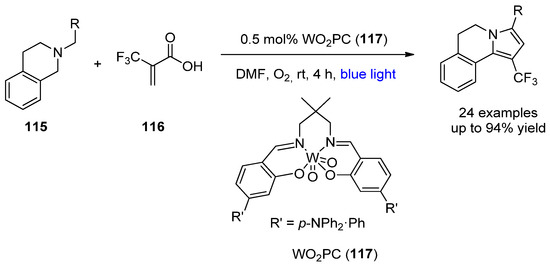
Scheme 17.
Construction of a lamellarin core through a photocatalytic pathway.
In general, most approaches are based on the functionalization of the commercially available pyrrole enroute to the natural product or the construction of a functionalized pyrrole to continue the synthesis. In any case, there is still no reported chemical synthesis for some of these derivatives and some retrosynthetic efforts have been made to increase their diversity.
Khan’s group demonstrated a scalable total synthesis of lamellarins S, Z, G, L, N and D in 5 or 6 steps (20–27% of overall yield). A retrosynthetic analysis was based on a double Pd-mediated cross dehydrogenative coupling (CDC) which would construct the desired core after oxidation. Then, a coupling of the carboxylic acid 120 with phenols would account for the introduction of the new ring. Finally, a [3 + 2] cycloaddition strategy of aziridine-2-carboxylates (121) and β-bromo-β-nitrostyrenes (122) would afford the desired pyrrole ring (Scheme 18) [115].
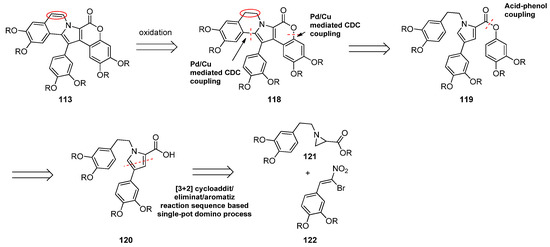
Scheme 18.
Retrosynthetic pathway in the construction of lamellarins.
2.5. Ningalins
Ningalin derivatives contain one or two coumarin scaffolds fused to a pyrrol ring. Some of these structures have been found from marine sources, containing penta- and tricyclic scaffolds. Particularly, ningalins A (123), B (124), F (125) and E (126) have been isolated from the ascidian Didemnun and/or sponge Iotrochota baculifera in the Ningallo reef region in Australia, giving the name to this family (Figure 11) [116,117]. One of the most remarkable activities of ningalin analogues is their ability to suppress HIV replication. In this regard, the structures in Figure 11 have been able to act as potent inhibitors against the HIV-1 IIIB virus in both MT4 and MAGI cell lines [117,118]. In addition, they also show potent inhibition against kinases related with neurodegenerative diseases, such as cyclic-dependent kinase 5 (CDK5), glycogen synthase kinase 3b (GSK3b) and casein kinase I (CD1d) [116].
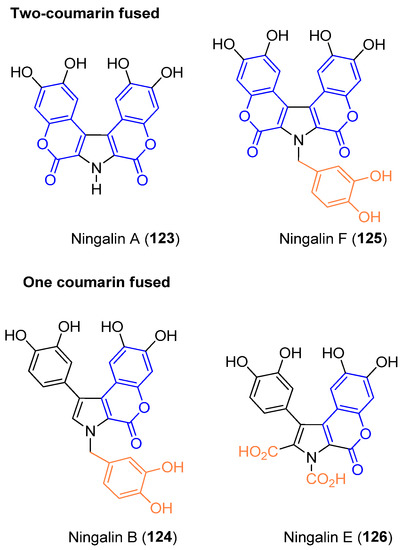
Figure 11.
Ningalin derivatives from marine sources.
To illustrate the synthetic approaches of this family, we chose 124 as a representative example. In this sense, many of the most recent strategies developed have been based on describing a new synthetic methodology and applying it to the preparation of the ningalin. For instance, Okano et al. developed a convergent total synthesis starting from a dibromopyrrole derivative [111]. A double Suzuki–Miyaura coupling generated the corresponding diarylated pyrrole 129. Then, removal of the SEM group via an intramolecular cyclization step gave rise to the tricyclic analogue 130. The desired product 124 was obtained under Mitsunobu conditions and hydrogenolysis, in a 97% yield (Scheme 19).
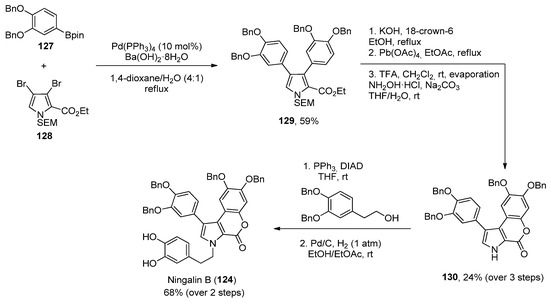
Scheme 19.
Synthetic methodology for the preparation of ningalin B (124).
Moreover, a one-pot multistep methodology for the construction of this core was reported in 2019 by Yang and colleagues. This methodology, comprising coupling, hydrolysis, reduction and cyclization steps, generated the derivative 134. Subsequent N-alkylation in the presence of a base and final demethylation gave rise to 124 with an overall yield of 42% (Scheme 20) [119].
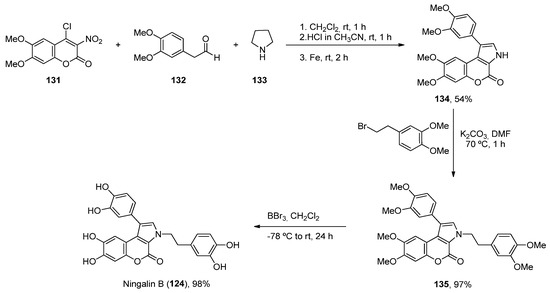
Scheme 20.
One-step synthetic protocol for the preparation of ningalin B (124).
2.6. Other Coumarin Derivatives: Bicoumarins and Tetracyclics
Many of the coumarin derivatives already shown are constituted by 3- or 5- fused cycles and have been classified considering this criterion. Nevertheless, other scaffolds have been found in different types of Aspergillus in Australia, which have been identified as dimers of coumarin, demethylkotanin (136) and bicoumanigrin (137) or with a tetracyclic core, aspergiolide A (138) and B (139) [120,121,122] (Figure 12). The antiproliferative activity and pharmacokinetic properties of 138 and 139 have been measured against several cancer cell lines. The best results have been displayed in A-549 and HL-60, with IC50 = 0.13 and 0.28 μM for 138, and IC50 = 0.24 and 0.51 μM for 139, respectively. Moreover, an in silico analysis of aspergiolide B (139) indicated a low binding free energy in the active site, which could be a potential EGFR-TK inhibitor [123].
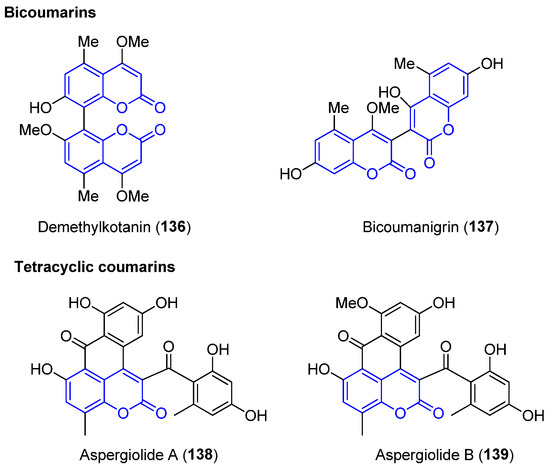
Figure 12.
Examples of other coumarin derivatives from marine sources.
To the best of our knowledge, the total synthesis of 138 and 139 has not yet been described. However, Li, Liu and colleagues developed a strategy for the preparation of the main core in 2019 [124]. Moreover, a library of simplified analogues was synthetized and evaluated against various cell lines. The core structure (143) was constructed in a two-step procedure based on the Knoevenagel condensation and transesterification sequence, followed by an intramolecular Friedel–Crafts acylation. This protocol implies an advance in the underdeveloped synthesis of aspergiolides (Scheme 21).

Scheme 21.
Synthesis of the aspergiolides core 143.
3. Conclusions
The ocean is still an underexplored world in the search for active molecules around Earth’s different environments. Here, coumarin derivatives have been identified in a variety of living organisms. They present a diverse set of structural features which confer interesting biological properties that have been tested in a plethora of cell lines and other enzymatic assays. Particularly, some of these derivatives and analogues have been highlighted because of their antitumor, antioxidant, antimicrobial and/or enzymatic inhibitory properties. For instance, psoralene and alternariol derivatives show promising cytostatic and photochemotherapeutic properties against KB and KBV200. Ningalins act as potent inhibitors against the HIV-1 virus and kinases related with neurodegenerative diseases (CDK5, GSK3b, CD1d). Lamellarins have been tested in a number of cell lines, demonstrating cytotoxic and antitumor effects, and being the most interesting due to their pharmacological properties. Although the extraction of coumarin derivatives from oceans is tedious, and low quantities are normally obtained, many synthetic efforts have been made to achieve efficient synthetic methodologies. Classical strategies involving Knoevenagel, Pechmann and Perkin condensations, as well as Wittig or ring-closing metathesis, have been used to construct the coumarin core. The total syntheses of trichodermamides, aflatoxins and lamellarins have been extensively carried out during the last decades. Moreover, transition metal catalysis, photocatalysis or even multicomponent approaches have been used as convenient strategies to expand the chemical space of coumarin derivatives. We envision that chemical modifications of marine-derived coumarins may improve their pharmacological properties and provide a step forward in the development of new therapies.
Author Contributions
Writing—original draft preparation, L.F.-P.; writing—review and editing, M.J.M. and E.L. All authors have read and agreed to the published version of the manuscript.
Funding
This research was funded by the Junta de Castilla y León, grant number VA294-P18, and the Ministerio de Ciencia e Innovación (PID2020-116076RJI00/AEI/10.13039/501100011033).
Acknowledgments
The authors want to thank A. Barbero for the revision of the manuscript. L.F.-P. acknowledges the predoctoral grant funded by the European Social Fund and the “Junta de Castilla y León”. M.J.M. acknowledges the project funded by the Agencia Estatal de Investigación, Ministerio de Ciencia e Innovación.
Conflicts of Interest
The authors declare no conflict of interest.
References
- Vazquez-Rodriguez, S.; Matos, M.J.; Borges, F.; Uriarte, E.; Santana, L. Bioactive coumarins from marine sources: Origin, structural features and pharmacological properties. Curr. Top. Med. Chem. 2015, 15, 1755–1766. [Google Scholar] [CrossRef] [PubMed]
- Fernández-Peña, L.; Díez-Poza, C.; González-Andrés, P.; Barbero, A. The Tetrahydrofuran Motif in Polyketide Marine Drugs. Mar. Drugs 2022, 20, 120. [Google Scholar] [CrossRef] [PubMed]
- Boström, J.; Brown, D.G.; Young, R.J.; Keserü, G.M. Expanding the medicinal chemistry synthetic toolbox. Nat. Rev. Drug Discov. 2018, 17, 709–727. [Google Scholar] [CrossRef]
- Malve, H. Exploring the ocean for new drug developments: Marine pharmacology. J. Pharm. Bioallied Sci. 2016, 8, 83–91. [Google Scholar] [CrossRef] [PubMed]
- Montaser, R.; Luesch, H. Marine natural products: A new wave of drugs? Future Med. Chem. 2011, 3, 1475–1489. [Google Scholar] [CrossRef]
- Martins, A.; Vieira, H.; Gaspar, H.; Santos, S. Marketed marine natural products in the pharmaceutical and cosmeceutical industries: Tips for success. Mar. Drugs 2014, 12, 1066–1101. [Google Scholar] [CrossRef]
- Haefner, B. Drugs from the deep: Marine natural products as drug candidates. Drug Discov. Today 2003, 8, 536–544. [Google Scholar] [CrossRef]
- Stefanachi, A.; Leonetti, F.; Pisani, L.; Catto, M.; Carotti, A. Coumarin: A natural, privileged and versatile scaffold for bioactive compounds. Molecules 2018, 23, 250. [Google Scholar] [CrossRef]
- Carneiro, A.; Matos, M.J.; Uriarte, E.; Santana, L. Trending Topics on Coumarin and Its Derivatives in 2020. Molecules 2021, 26, 501. [Google Scholar] [CrossRef]
- Murray, R.D. The naturally occurring coumarins. Prog. Chem. Org. Nat. Prod. 2002, 1–619. [Google Scholar] [CrossRef]
- Annunziata, F.; Pinna, C.; Dallavalle, S.; Tamborini, L.; Pinto, A. An overview of coumarin as a versatile and readily accessible scaffold with broad-ranging biological activities. Int. J. Mol. Sci. 2020, 21, 4618. [Google Scholar] [CrossRef]
- Matos, M.J. Coumarin and Its Derivatives—Editorial. Molecules 2021, 26, 6320. [Google Scholar] [CrossRef] [PubMed]
- Vekariya, R.H.; Patel, H.D. Recent advances in the synthesis of coumarin derivatives via Knoevenagel condensation: A review. Synth. Commun. 2014, 44, 2756–2788. [Google Scholar] [CrossRef]
- Fotopoulos, I.; Hadjipavlou-Litina, D. Hybrids of coumarin derivatives as potent and multifunctional bioactive agents: A review. Med. Chem. 2020, 16, 272–306. [Google Scholar] [CrossRef] [PubMed]
- Feng, D.; Zhang, A.; Yang, Y.; Yang, P. Coumarin-containing hybrids and their antibacterial activities. Arch. Pharm. 2020, 353, 1900380. [Google Scholar] [CrossRef] [PubMed]
- Song, X.F.; Fan, J.; Liu, L.; Liu, X.F.; Gao, F. Coumarin derivatives with anticancer activities: An update. Arch. Pharm. 2020, 353, 2000025. [Google Scholar] [CrossRef] [PubMed]
- Küpeli Akkol, E.; Genç, Y.; Karpuz, B.; Sobarzo-Sánchez, E.; Capasso, R. Coumarins and coumarin-related compounds in pharmacotherapy of cancer. Cancers 2020, 12, 1959. [Google Scholar] [CrossRef]
- Al-Warhi, T.; Sabt, A.; Elkaeed, E.B.; Eldehna, W.M. Recent advancements of coumarin-based anticancer agents: An up-to-date review. Bioorg. Chem. 2020, 103, 104163. [Google Scholar] [CrossRef]
- Goud, N.S.; Kumar, P.; Bharath, R.D. Recent developments of target based coumarin derivatives as potential anticancer agents. Mini Rev. Med. Chem. 2020, 20, 1754–1766. [Google Scholar] [CrossRef]
- Menichelli, D.; Poli, D.; Antonucci, E.; Cammisotto, V.; Testa, S.; Pignatelli, P.; Palareti, G.; Pastori, D.; Clinics, I.F.o.A. Comparison of anticoagulation quality between acenocoumarol and warfarin in patients with mechanical prosthetic heart valves: Insights from the nationwide PLECTRUM study. Molecules 2021, 26, 1425. [Google Scholar] [CrossRef]
- Kang, J.K.; Hyun, C.-G. 4-Hydroxy-7-methoxycoumarin inhibits inflammation in LPS-activated RAW264. 7 macrophages by suppressing NF-κB and MAPK activation. Molecules 2020, 25, 4424. [Google Scholar] [CrossRef] [PubMed]
- Di Stasi, L.C. Coumarin derivatives in inflammatory bowel disease. Molecules 2021, 26, 422. [Google Scholar] [CrossRef] [PubMed]
- Moya-Alvarado, G.; Yañez, O.; Morales, N.; González-González, A.; Areche, C.; Núñez, M.T.; Fierro, A.; García-Beltrán, O. Coumarin-chalcone hybrids as inhibitors of MAO-B: Biological activity and in silico studies. Molecules 2021, 26, 2430. [Google Scholar] [CrossRef] [PubMed]
- Vazquez-Rodriguez, S.; Vilar, S.; Kachler, S.; Klotz, K.-N.; Uriarte, E.; Borges, F.; Matos, M.J. Adenosine Receptor Ligands: Coumarin–Chalcone Hybrids as Modulating Agents on the Activity of h ARs. Molecules 2020, 25, 4306. [Google Scholar] [CrossRef] [PubMed]
- Phutdhawong, W.; Chuenchid, A.; Taechowisan, T.; Sirirak, J.; Phutdhawong, W.S. Synthesis and biological activity evaluation of coumarin-3-carboxamide derivatives. Molecules 2021, 26, 1653. [Google Scholar] [CrossRef]
- Sumorek-Wiadro, J.; Zając, A.; Langner, E.; Skalicka-Woźniak, K.; Maciejczyk, A.; Rzeski, W.; Jakubowicz-Gil, J. Antiglioma potential of coumarins combined with Sorafenib. Molecules 2020, 25, 5192. [Google Scholar] [CrossRef]
- Lončarić, M.; Gašo-Sokač, D.; Jokić, S.; Molnar, M. Recent advances in the synthesis of coumarin derivatives from different starting materials. Biomolecules 2020, 10, 151. [Google Scholar] [CrossRef]
- Tsivileva, O.M.; Koftin, O.V.; Evseeva, N.V. Coumarins as Fungal Metabolites with Potential Medicinal Properties. Antibiotics 2022, 11, 1156. [Google Scholar] [CrossRef]
- Garg, S.S.; Gupta, J.; Sharma, S.; Sahu, D. An insight into the therapeutic applications of coumarin compounds and their mechanisms of action. Eur. J. Pharm. Sci. 2020, 152, 105424. [Google Scholar] [CrossRef]
- Huang, Z.; Yang, J.; Cai, X.; She, Z.; Lin, Y. A new furanocoumarin from the mangrove endophytic fungus Penicillium sp. (ZH16). Nat. Prod. Res. 2012, 26, 1291–1295. [Google Scholar] [CrossRef]
- Lino, C.; Taveira, M.; Viana, G.; Matos, F. Analgesic and antiinflammatory activities of Justicia pectoralis Jacq and its main constituents: Coumarin and umbelliferone. Phytother. Res. 1997, 11, 211–215. [Google Scholar] [CrossRef]
- Stefanova, T.H.; Nikolova, N.J.; Toshkova, R.A.; Neychev, H.O. Antitumor and immunomodulatory effect of coumarin and 7-hydroxycoumarin against Sarcoma 180 in mice. J. Exp. Ther. Oncol. 2007, 6, 107–115. [Google Scholar] [PubMed]
- Yu, S.M.; Hu, D.H.; Zhang, J.J. Umbelliferone exhibits anticancer activity via the induction of apoptosis and cell cycle arrest in HepG2 hepatocellular carcinoma cells. Mol. Med. Rep. 2015, 12, 3869–3873. [Google Scholar] [CrossRef] [PubMed]
- Liu, X.L.; Zhang, L.; Fu, X.L.; Chen, K.; Qian, B.C. Effect of scopoletin on PC3 cell proliferation and apoptosis. Acta Pharmacol. Sin. 2001, 22, 929–933. [Google Scholar] [PubMed]
- Hornick, A.; Lieb, A.; Vo, N.P.; Rollinger, J.M.; Stuppner, H.; Prast, H. The coumarin scopoletin potentiates acetylcholine release from synaptosomes, amplifies hippocampal long-term potentiation and ameliorates anticholinergic- and age-impaired memory. Neuroscience 2011, 197, 280–292. [Google Scholar] [CrossRef]
- Anand, P.; Singh, B.; Singh, N. A review on coumarins as acetylcholinesterase inhibitors for Alzheimer’s disease. Biorg. Med. Chem. 2012, 20, 1175–1180. [Google Scholar] [CrossRef]
- Kostova, I.; Bhatia, S.; Grigorov, P.; Balkansky, S.; Parmar, V.S.; Prasad, A.K.; Saso, L. Coumarins as antioxidants. Curr. Med. Chem. 2011, 18, 3929–3951. [Google Scholar] [CrossRef]
- Salem, M.A.; Helal, M.H.; Gouda, M.A.; Ammar, Y.A.; El-Gaby, M.S.A.; Abbas, S.Y. An overview on synthetic strategies to coumarins. Synth. Commun. 2018, 48, 1534–1550. [Google Scholar] [CrossRef]
- Venugopala, K.N.; Rashmi, V.; Odhav, B. Review on natural coumarin lead compounds for their pharmacological activity. BioMed Res. Int. 2013, 2013, 963248. [Google Scholar] [CrossRef]
- Shakil, M.R.; Meguerdichian, A.G.; Tasnim, H.; Shirazi-Amin, A.; Seraji, M.S.; Suib, S.L. Syntheses of ZnO with Different Morphologies: Catalytic Activity toward Coumarin Synthesis via the Knoevenagel Condensation Reaction. Inorg. Chem. 2019, 58, 5703–5714. [Google Scholar] [CrossRef]
- Zhang, S.; Tan, X.; Liang, C.; Zhang, W. Design, synthesis, and antifungal evaluation of novel coumarin-pyrrole hybrids. J. Heterocycl. Chem. 2021, 58, 450–458. [Google Scholar] [CrossRef]
- Augustine, J.K.; Bombrun, A.; Ramappa, B.; Boodappa, C. An efficient one-pot synthesis of coumarins mediated by propylphosphonic anhydride (T3P) via the Perkin condensation. Tetrahedron Lett. 2012, 53, 4422–4425. [Google Scholar] [CrossRef]
- Belavagi, N.S.; Deshapande, N.; Sunagar, M.G.; Khazi, I.A.M. A practical one-pot synthesis of coumarins in aqueous sodium bicarbonate via intramolecular Wittig reaction at room temperature. RSC Adv. 2014, 4, 39667–39671. [Google Scholar] [CrossRef]
- Upadhyay, P.K.; Kumar, P. A novel synthesis of coumarins employing triphenyl(α-carboxymethylene)phosphorane imidazolide as a C-2 synthon. Tetrahedron Lett. 2009, 50, 236–238. [Google Scholar] [CrossRef]
- Pünkösti, Z.; Kele, P.; Herner, A. Synthesis of 7-Azido-3-Formylcoumarin—A Key Precursor in Bioorthogonally Applicable Fluorogenic Dye Synthesis. J. Heterocycl. Chem. 2018, 55, 1183–1188. [Google Scholar] [CrossRef]
- Polito, L.; Cravini, M.; Poletti, L.; Lay, L. Simple Synthesis of Versatile Coumarin Scaffolds. Synth. Commun. 2006, 36, 2203–2209. [Google Scholar] [CrossRef]
- Chandrasekhar, S.; Kumar, H.V. An Expeditious Coumarin Synthesis via a “Pseudocycloaddition” Between Salicylaldehydes and Ketene. Synth. Commun. 2015, 45, 232–235. [Google Scholar] [CrossRef]
- Li, C.; Zhu, H.; Zhang, H.; Yang, Y.; Wang, F. Synthesis of 2H-Chromenones from Salicylaldehydes and Arylacetonitriles. Molecules 2017, 22, 1197. [Google Scholar] [CrossRef]
- Sharma, U.; Naveen, T.; Maji, A.; Manna, S.; Maiti, D. Palladium-Catalyzed Synthesis of Benzofurans and Coumarins from Phenols and Olefins. Angew. Chem. Int. Ed. 2013, 52, 12669–12673. [Google Scholar] [CrossRef]
- Wienhold, M.; Molloy, J.J.; Daniliuc, C.G.; Gilmour, R. Coumarins by Direct Annulation: β-Borylacrylates as Ambiphilic C3-Synthons. Angew. Chem. Int. Ed. 2021, 133, 695–699. [Google Scholar] [CrossRef]
- Gadakh, S.K.; Dey, S.; Sudalai, A. Rh-Catalyzed Synthesis of Coumarin Derivatives from Phenolic Acetates and Acrylates via C–H Bond Activation. J. Org. Chem. 2015, 80, 11544–11550. [Google Scholar] [CrossRef] [PubMed]
- Kutubi, M.S.; Hashimoto, T.; Kitamura, T. Improved Synthesis of Coumarins by Iron(III)-Catalyzed Cascade Reaction of Propiolic Acids and Phenols. Synthesis 2011, 2011, 1283–1289. [Google Scholar] [CrossRef]
- Liu, X.-G.; Zhang, S.-S.; Jiang, C.-Y.; Wu, J.-Q.; Li, Q.; Wang, H. Cp*Co(III)-Catalyzed Annulations of 2-Alkenylphenols with CO: Mild Access to Coumarin Derivatives. Org. Lett. 2015, 17, 5404–5407. [Google Scholar] [CrossRef] [PubMed]
- Fiorito, S.; Epifano, F.; Taddeo, V.A.; Genovese, S. Ytterbium triflate promoted coupling of phenols and propiolic acids: Synthesis of coumarins. Tetrahedron Lett. 2016, 57, 2939–2942. [Google Scholar] [CrossRef]
- Konrádová, D.; Kozubíková, H.; Doležal, K.; Pospíšil, J. Microwave-Assisted Synthesis of Phenylpropanoids and Coumarins: Total Synthesis of Osthol. Eur. J. Org. Chem. 2017, 2017, 5204–5213. [Google Scholar] [CrossRef]
- Li, X.; Chen, A.; Zhou, Y.; Huang, L.; Fang, Z.; Gan, H.; Guo, K. Two-stage flow synthesis of coumarin via O-acetylation of salicylaldehyde. J. Flow Chem. 2015, 5, 82–86. [Google Scholar] [CrossRef]
- Zhao, B.; Xu, B. Visible-light promoted oxidative cyclization of cinnamic acid derivatives using xanthone as the photocatalyst. Org. Biomol. Chem. 2021, 19, 568–573. [Google Scholar] [CrossRef]
- Valizadeh, H.; Vaghefi, S. One-Pot Wittig and Knoevenagel Reactions in Ionic Liquid as Convenient Methods for the Synthesis of Coumarin Derivatives. Synth. Commun. 2009, 39, 1666–1678. [Google Scholar] [CrossRef]
- Prabhala, P.; Savanur, H.M.; Sutar, S.M.; Malunavar, S.S.; Kalkhambkar, R.G.; Laali, K.K. Facile one-pot synthetic access to libraries of diversely substituted 3-aryl (Alkyl)-coumarins using ionic liquid (IL) or conventional base/solvent, and an IL-mediated approach to novel coumarin-bearing diaryl-ethynes. Tetrahedron Lett. 2020, 61, 151854. [Google Scholar] [CrossRef]
- Wei, J.; Wang, P.; Jia, Q.; Huang, J.; Du, Z.; Zhang, K.; Wang, J. Amine-Catalyzed Cascade Synthesis of 3,4-Diunsubstituted Coumarins. Eur. J. Org. Chem. 2013, 2013, 4499–4502. [Google Scholar] [CrossRef]
- Zhan, K.; Li, Y. Visible-Light photocatalytic E to Z isomerization of activated olefins and its application for the syntheses of coumarins. Catalysts 2017, 7, 337. [Google Scholar] [CrossRef]
- Shu, P.; Xu, H.; Zhang, L.; Li, J.; Liu, H.; Luo, Y.; Yang, X.; Ju, Z.; Xu, Z. Synthesis of (Z)-Cinnamate Derivatives via Visible-Light-Driven E-to-Z Isomerization. SynOpen 2019, 03, 103–107. [Google Scholar] [CrossRef]
- Cervi, A.; Vo, Y.; Chai, C.L.L.; Banwell, M.G.; Lan, P.; Willis, A.C. Gold(I)-Catalyzed Intramolecular Hydroarylation of Phenol-Derived Propiolates and Certain Related Ethers as a Route to Selectively Functionalized Coumarins and 2H-Chromenes. J. Org. Chem. 2021, 86, 178–198. [Google Scholar] [CrossRef] [PubMed]
- Choi, H.; Kim, J.; Lee, K. Metal-free, Brønsted acid-mediated synthesis of coumarin derivatives from phenols and propiolic acids. Tetrahedron Lett. 2016, 57, 3600–3603. [Google Scholar] [CrossRef]
- Tao, L.-y.; Zhang, J.-y.; Liang, Y.-j.; Chen, L.-m.; Zheng, L.-s.; Wang, F.; Mi, Y.-j.; She, Z.-g.; To, K.K.W.; Lin, Y.-c.; et al. Anticancer Effect and Structure-Activity Analysis of Marine Products Isolated from Metabolites of Mangrove Fungi in the South China Sea. Mar. Drugs 2010, 8, 1094–1105. [Google Scholar] [CrossRef]
- Garo, E.; Starks, C.M.; Jensen, P.R.; Fenical, W.; Lobkovsky, E.; Clardy, J. Trichodermamides A and B, Cytotoxic Modified Dipeptides from the Marine-Derived Fungus Trichoderma virens. J. Nat. Prod. 2003, 66, 423–426. [Google Scholar] [CrossRef] [PubMed]
- Liu, R.; Gu, Q.-Q.; Zhu, W.-M.; Cui, C.-B.; Fan, G.-T. Trichodermamide A and aspergillazine A, two cytotoxic modified dipeptides from a marine-derived fungus Spicaria elegans. Arch. Pharmacal. Res. 2005, 28, 1042–1046. [Google Scholar] [CrossRef]
- Wang, Y.; Lu, Z.; Sun, K.; Zhu, W. Effects of High Salt Stress on Secondary Metabolite Production in the Marine-Derived Fungus Spicaria elegans. Mar. Drugs 2011, 9, 535–542. [Google Scholar] [CrossRef]
- Capon, R.J.; Ratnayake, R.; Stewart, M.; Lacey, E.; Tennant, S.; Gill, J.H. Aspergillazines A–E: Novel heterocyclic dipeptides from an Australian strain of Aspergillus unilateralis. Org. Biomol. Chem. 2005, 3, 123–129. [Google Scholar] [CrossRef]
- Jans, P.E.; Mfuh, A.M.; Arman, H.D.; Shaffer, C.V.; Larionov, O.V.; Mooberry, S.L. Cytotoxicity and Mechanism of Action of the Marine-Derived Fungal Metabolite Trichodermamide B and Synthetic Analogues. J. Nat. Prod. 2017, 80, 676–683. [Google Scholar] [CrossRef]
- Yamazaki, H.; Rotinsulu, H.; Takahashi, O.; Kirikoshi, R.; Namikoshi, M. Induced production of a new dipeptide with a disulfide bridge by long-term fermentation of marine-derived Trichoderma cf. brevicompactum. Tetrahedron Lett. 2016, 57, 5764–5767. [Google Scholar] [CrossRef]
- Matsuo, H.; Hokari, R.; Ishiyama, A.; Iwatsuki, M.; Higo, M.; Nonaka, K.; Nagano, Y.; Takahashi, Y.; Ōmura, S.; Nakashima, T. Hatsusamides A and B: Two New Metabolites Produced by the Deep-Sea-Derived Fungal Strain Penicillium steckii FKJ-0213. Mar. Drugs 2020, 18, 513. [Google Scholar] [CrossRef] [PubMed]
- Davis, R.A.; Longden, J.; Avery, V.M.; Healy, P.C. The isolation, structure determination and cytotoxicity of the new fungal metabolite, trichodermamide C. Bioorg. Med. Chem. Lett. 2008, 18, 2836–2839. [Google Scholar] [CrossRef] [PubMed]
- Wan, X.; Joullié, M.M. Enantioselective Total Syntheses of Trichodermamides A and B. J. Am. Chem. Soc. 2008, 130, 17236–17237. [Google Scholar] [CrossRef]
- Mfuh, A.M.; Zhang, Y.; Stephens, D.E.; Vo, A.X.T.; Arman, H.D.; Larionov, O.V. Concise Total Synthesis of Trichodermamides A, B, and C Enabled by an Efficient Construction of the 1,2-Oxazadecaline Core. J. Am. Chem. Soc. 2015, 137, 8050–8053. [Google Scholar] [CrossRef]
- Reich, H.J. Organoselenium chemistry. Synthetic transformations based on allyl selenide anions. J. Org. Chem. 1975, 40, 2570–2572. [Google Scholar] [CrossRef]
- Lu, C.-D.; Zakarian, A. Total Synthesis of (±)-Trichodermamide B and of a Putative Biosynthetic Precursor to Aspergillazine A Using an Oxaza-Cope Rearrangement. Angew. Chem. Int. Ed. 2008, 47, 6829–6831. [Google Scholar] [CrossRef]
- Santana, L.; Uriarte, E.; Roleira, F.; Milhazes, N.; Borges, F. Furocoumarins in medicinal chemistry. Synthesis, natural occurrence and biological activity. Curr. Med. Chem. 2004, 11, 3239–3261. [Google Scholar] [CrossRef] [PubMed]
- Uwaifo, A.O.; Billings, P.C.; Heidelberger, C. Mutation of Chinese Hamster V79 Cells and Transformation and Mutation of Mouse Fibroblast C3H/10T½ Clone 8 Cells by Aflatoxin B1 and Four Other Furocoumarins Isolated from Two Nigerian Medicinal Plants. Cancer Res. 1983, 43, 1054–1058. [Google Scholar] [PubMed]
- Cadierno, V. Metal-catalyzed routes for the synthesis of furocoumarins and coumestans. In Green Synthetic Approaches for Biologically Relevant Heterocycles; Elsevier: Amsterdam, The Netherlands, 2021; pp. 53–96. [Google Scholar]
- Rao, M.L.; Nand, S.; Murty, V.N. Metal-Catalyzed Divergent Synthetic Methods for Pyrrolocoumarins and Furocoumarins. Asian J. Org. Chem. 2022, 11, e202100604. [Google Scholar] [CrossRef]
- Cai, X.; Ji, D.; Liu, J.; Hu, M.; Jin, Z. A New Approach to the Synthesis of Bergapten. Chem. Res. Chin. Univ. 2022, 31, 1–5. [Google Scholar] [CrossRef]
- Tan, N.; Tao, Y.; Pan, J.; Wang, S.; Xu, F.; She, Z.; Lin, Y.; Gareth Jones, E. Isolation, structure elucidation, and mutagenicity of four alternariol derivatives produced by the mangrove endophytic fungus No. 2240. Chem. Nat. Compd. 2008, 44, 296–300. [Google Scholar] [CrossRef]
- Jasim, S.; Mustafa, Y. A Review of Classical and Advanced Methodologies for Benzocoumarin Synthesis. J. Med. Chem. Sci. 2022, 5, 676–694. [Google Scholar] [CrossRef]
- Koch, K.; Podlech, J.; Pfeiffer, E.; Metzler, M. Total synthesis of alternariol. J. Org. Chem. 2005, 70, 3275–3276. [Google Scholar] [CrossRef]
- Won, M.; Kwon, S.; Kim, T.-H. An efficient synthesis of alternariol. J. Korean Chem. Soc. 2015, 59, 471–474. [Google Scholar] [CrossRef][Green Version]
- Gallardo-Donaire, J.; Martin, R. Cu-catalyzed mild C (sp2)–H functionalization assisted by carboxylic acids en route to hydroxylated arenes. J. Am. Chem. Soc. 2013, 135, 9350–9353. [Google Scholar] [CrossRef] [PubMed]
- Krzeszewski, M.; Vakuliuk, O.; Gryko, D.T. Color-tunable fluorescent dyes based on benzo [c] coumarin. Eur. J. Org. Chem. 2013, 2013, 5631–5644. [Google Scholar] [CrossRef]
- Pottie, I.R.; Nandaluru, P.R.; Benoit, W.L.; Miller, D.O.; Dawe, L.N.; Bodwell, G.J. Synthesis of 6 H-Dibenzo [b,d] pyran-6-ones Using the Inverse Electron Demand Diels–Alder Reaction. J. Org. Chem. 2011, 76, 9015–9030. [Google Scholar] [CrossRef]
- Nandaluru, P.R.; Bodwell, G.J. Multicomponent Synthesis of 6 H-Dibenzo [b, d] pyran-6-ones and a Total Synthesis of Cannabinol. Org. Lett. 2012, 14, 310–313. [Google Scholar] [CrossRef]
- Poudel, T.N.; Lee, Y.R. An advanced and novel one-pot synthetic method for diverse benzo [c] chromen-6-ones by transition-metal free mild base-promoted domino reactions of substituted 2-hydroxychalcones with β-ketoesters and its application to polysubstituted terphenyls. Org. Biomol. Chem. 2014, 12, 919–930. [Google Scholar] [CrossRef]
- Grkovic, T.; Pouwer, R.H.; Vial, M.L.; Gambini, L.; Noël, A.; Hooper, J.N.; Wood, S.A.; Mellick, G.D.; Quinn, R.J. NMR Fingerprints of the Drug-like Natural-Product Space Identify Iotrochotazine A: A Chemical Probe to Study Parkinson’s Disease. Angew. Chem. Int. Ed. 2014, 53, 6070–6074. [Google Scholar] [CrossRef]
- Takara, K.; Kuniyoshi, A.; Wada, K.; Kinjyo, K.; Iwasaki, H. Antioxidative flavan-3-ol glycosides from stems of Rhizophora stylosa. Biosci. Biotechnol. Biochem. 2008, 72, 2191–2194. [Google Scholar] [CrossRef] [PubMed]
- Bandaranayake, W.M. Bioactivities, bioactive compounds and chemical constituents of mangrove plants. Wetl. Ecol. Manag. 2002, 10, 421–452. [Google Scholar] [CrossRef]
- Awale, S.; Tezuka, Y.; Wang, S.; Kadota, S. Facile and regioselective synthesis of phenylpropanoid-substituted flavan-3-ols. Org. Lett. 2002, 4, 1707–1709. [Google Scholar] [CrossRef]
- Lin, A.-Q.; Du, L.; Fang, Y.-C.; Wang, F.-Z.; Zhu, T.-J.; Gu, Q.-Q.; Zhu, W.-M. iso-α-Cyclopiazonic acid, a new natural product isolated from the marine-derived fungus Aspergillus flavus CF-3. Chem. Nat. Compd. 2009, 45, 677–680. [Google Scholar] [CrossRef]
- Wang, H.; Lu, Z.; Qu, H.-J.; Liu, P.; Miao, C.; Zhu, T.; Li, J.; Hong, K.; Zhu, W. Antimicrobial aflatoxins from the marine-derived fungus Aspergillus flavus 092008. Arch. Pharmacal. Res. 2012, 35, 1387–1392. [Google Scholar] [CrossRef] [PubMed]
- Fine, G.A. Magical Mushrooms, Mischievous Molds: The Remarkable Story of the Fungus Kingdom and Its Impact on Human Affairs. Am. Sci. 1998, 86, 578–579. [Google Scholar]
- Wang, Z.; Yang, L. Advances in the Total Synthesis of Aflatoxins. Front. Chem. 2021, 30, 1024. [Google Scholar] [CrossRef]
- Buechi, G.; Foulkes, D.; Kurono, M.; Mitchell, G.F.; Schneider, R.S. Total synthesis of racemic aflatoxin B1. J. Am. Chem. Soc. 1967, 89, 6745–6753. [Google Scholar] [CrossRef]
- Trost, B.M.; Toste, F.D. Palladium Catalyzed Kinetic and Dynamic Kinetic Asymmetric Transformations of γ-Acyloxybutenolides. Enantioselective Total Synthesis of (+)-Aflatoxin B1 and B2a. J. Am. Chem. Soc. 2003, 125, 3090–3100. [Google Scholar] [CrossRef]
- Pla, D.; Albericio, F.; Álvarez, M. Recent advances in lamellarin alkaloids: Isolation, synthesis and activity. Anticancer Agents Med. Chem. 2008, 8, 746–760. [Google Scholar] [CrossRef] [PubMed]
- Fukuda, T.; Ishibashi, F.; Iwao, M. Lamellarin alkaloids: Isolation, synthesis, and biological activity. Alkaloids Chem. Biol. 2020, 83, 1–112. [Google Scholar] [CrossRef] [PubMed]
- Facompré, M.; Tardy, C.; Bal-Mahieu, C.; Colson, P.; Perez, C.; Manzanares, I.; Cuevas, C.; Bailly, C. Lamellarin D: A novel potent inhibitor of topoisomerase I. Cancer Res. 2003, 63, 7392–7399. [Google Scholar]
- Reddy, S.M.; Srinivasulu, M.; Satyanarayana, N.; Kondapi, A.K.; Venkateswarlu, Y. New potent cytotoxic lamellarin alkaloids from Indian ascidian Didemnum obscurum. Tetrahedron 2005, 61, 9242–9247. [Google Scholar] [CrossRef]
- Plisson, F.; Huang, X.C.; Zhang, H.; Khalil, Z.; Capon, R.J. Lamellarins as Inhibitors of P-Glycoprotein-Mediated Multidrug Resistance in a Human Colon Cancer Cell Line. Chem. Asian J. 2012, 7, 1616–1623. [Google Scholar] [CrossRef]
- Pla, D.; Albericio, F.; Álvarez, M. Progress on lamellarins. MedChemComm 2011, 2, 689–697. [Google Scholar] [CrossRef]
- Silyanova, E.; Samet, A.; Semenov, V. A Two-Step Approach to a Hexacyclic Lamellarin Core via 1, 3-Dipolar Cycloaddition of Isoquinolinium Ylides to Nitrostilbenes. J. Org. Chem. 2022, 87, 6444–6453. [Google Scholar] [CrossRef] [PubMed]
- Liu, Z.; Liu, X.; Yang, S.; Miao, X.; Li, D.; Wang, D. Titanium-Mediated aza-Nazarov Annulation for the Synthesis of N-Fused Tricycles: A General Method to Access Lamellarin Analogues. J. Org. Chem. 2022, 87, 10319–10332. [Google Scholar] [CrossRef]
- Manjappa, B.K.; Lin, J.-M.; Yang, D.-Y. Construction of pentacyclic lamellarin skeleton via Grob reaction: Application to total synthesis of lamellarins H and D. J. Org. Chem. 2017, 82, 7648–7656. [Google Scholar] [CrossRef]
- Morikawa, D.; Morii, K.; Yasuda, Y.; Mori, A.; Okano, K. Convergent total synthesis of lamellarins and their congeners. J. Org. Chem. 2020, 85, 8603–8617. [Google Scholar] [CrossRef]
- Morii, K.; Yasuda, Y.; Morikawa, D.; Mori, A.; Okano, K. Total Synthesis of Lamellarins G, J, L, and Z Using One-Pot Halogen Dance/Negishi Coupling. J. Org. Chem. 2021, 86, 13388–13401. [Google Scholar] [CrossRef] [PubMed]
- Wang, Q.; Yuan, T.; Liu, Q.; Xu, Y.; Xie, G.; Lv, X.; Ding, S.; Wang, X.; Li, C. External oxidant-free oxidation/[3+ 2] cycloaddition/aromatization cascade: Electrochemical synthesis of polycyclic N-heterocycles. Chem. Commun. 2019, 55, 8398–8401. [Google Scholar] [CrossRef] [PubMed]
- Yu, D.; Liu, Y.; Che, C.-M. Tungsten catalysed decarboxylative [3+ 2] cycloaddition aromatization: One-pot synthesis of trifluoromethyl-pyrrolo [2, 1-a] isoquinolines with visible light irradiation. Org. Chem. Front. 2022, 9, 2779–2785. [Google Scholar] [CrossRef]
- Kumar, V.; Salam, A.; Kumar, D.; Khan, T. Concise and Scalable Total Syntheses of Lamellarin Z and other Natural Lamellarins. ChemistrySelect 2020, 5, 14510–14514. [Google Scholar] [CrossRef]
- Plisson, F.; Conte, M.; Khalil, Z.; Huang, X.C.; Piggott, A.M.; Capon, R.J. Kinase inhibitor scaffolds against neurodegenerative diseases from a Southern Australian ascidian, Didemnum sp. ChemMedChem 2012, 7, 983–990. [Google Scholar] [CrossRef]
- Fan, G.; Li, Z.; Shen, S.; Zeng, Y.; Yang, Y.; Xu, M.; Bruhn, T.; Bruhn, H.; Morschhäuser, J.; Bringmann, G. Baculiferins A–O, O-sulfated pyrrole alkaloids with anti-HIV-1 activity, from the Chinese marine sponge Iotrochota baculifera. Biorg. Med. Chem. 2010, 18, 5466–5474. [Google Scholar] [CrossRef]
- Ting-Chao, C. Immunosuppressive Ningalin Compounds. WO2006026496A2, 2004. Available online: https://patentscope.wipo.int/search/en/detail.jsf?docId=WO2006026496 (accessed on 2 November 2022).
- Wu, C.-K.; Weng, Z.; Yang, D.-Y. One-pot construction of 1-phenylchromeno [3, 4-b] pyrrol-4 (3 H)-one: Application to total synthesis of ningalin B and a pyrrolocoumarin-based electrochromic switch. Org. Lett. 2019, 21, 5225–5228. [Google Scholar] [CrossRef]
- Du, L.; Zhu, T.; Liu, H.; Fang, Y.; Zhu, W.; Gu, Q. Cytotoxic polyketides from a marine-derived fungus Aspergillus glaucus. J. Nat. Prod. 2008, 71, 1837–1842. [Google Scholar] [CrossRef]
- Ovenden, S.P.; Sberna, G.; Tait, R.M.; Wildman, H.G.; Patel, R.; Li, B.; Steffy, K.; Nguyen, N.; Meurer-Grimes, B.M. A Diketopiperazine Dimer from a Marine-Derived Isolate of Aspergillus niger. J. Nat. Prod. 2004, 67, 2093–2095. [Google Scholar] [CrossRef]
- Hiort, J.; Maksimenka, K.; Reichert, M.; Perović-Ottstadt, S.; Lin, W.; Wray, V.; Steube, K.; Schaumann, K.; Weber, H.; Proksch, P. New natural products from the sponge-derived fungus Aspergillus niger. J. Nat. Prod. 2004, 67, 1532–1543. [Google Scholar] [CrossRef]
- Matulja, D.; Vranješević, F.; Kolympadi Markovic, M.; Pavelić, S.K.; Marković, D. Anticancer Activities of Marine-Derived Phenolic Compounds and Their Derivatives. Molecules 2022, 27, 1449. [Google Scholar] [CrossRef] [PubMed]
- Qiao, L.; Duan, Z.; Chen, Y.; Luan, Y.; Gu, Q.; Liu, Y.-K.; Li, D. Aspergiolides A and B: Core Structural Establishment and Synthesis of Structural Analogues. J. Org. Chem. 2019, 84, 4451–4457. [Google Scholar] [CrossRef] [PubMed]
Disclaimer/Publisher’s Note: The statements, opinions and data contained in all publications are solely those of the individual author(s) and contributor(s) and not of MDPI and/or the editor(s). MDPI and/or the editor(s) disclaim responsibility for any injury to people or property resulting from any ideas, methods, instructions or products referred to in the content. |
© 2022 by the authors. Licensee MDPI, Basel, Switzerland. This article is an open access article distributed under the terms and conditions of the Creative Commons Attribution (CC BY) license (https://creativecommons.org/licenses/by/4.0/).